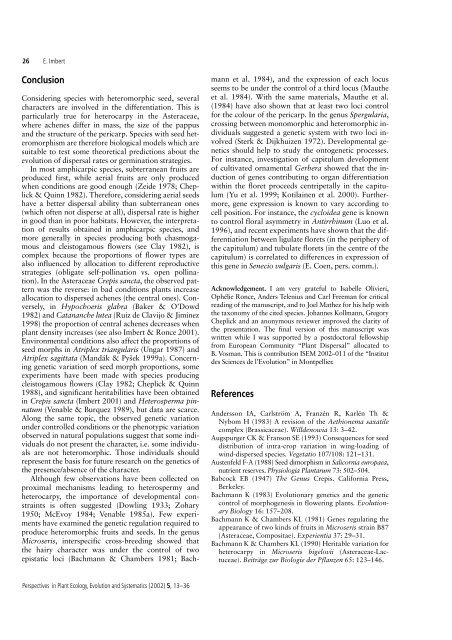Ecological consequences and ontogeny of seed ... - Accueil du site
Ecological consequences and ontogeny of seed ... - Accueil du site
Ecological consequences and ontogeny of seed ... - Accueil du site
Create successful ePaper yourself
Turn your PDF publications into a flip-book with our unique Google optimized e-Paper software.
26 E. Imbert<br />
Conclusion<br />
Considering species with heteromorphic <strong>seed</strong>, several<br />
characters are involved in the differentiation. This is<br />
particularly true for heterocarpy in the Asteraceae,<br />
where achenes differ in mass, the size <strong>of</strong> the pappus<br />
<strong>and</strong> the structure <strong>of</strong> the pericarp. Species with <strong>seed</strong> heteromorphism<br />
are therefore biological models which are<br />
suitable to test some theoretical predictions about the<br />
evolution <strong>of</strong> dispersal rates or germination strategies.<br />
In most amphicarpic species, subterranean fruits are<br />
pro<strong>du</strong>ced first, while aerial fruits are only pro<strong>du</strong>ced<br />
when conditions are good enough (Zeide 1978; Cheplick<br />
& Quinn 1982). Therefore, considering aerial <strong>seed</strong>s<br />
have a better dispersal ability than subterranean ones<br />
(which <strong>of</strong>ten not disperse at all), dispersal rate is higher<br />
in good than in poor habitats. However, the interpretation<br />
<strong>of</strong> results obtained in amphicarpic species, <strong>and</strong><br />
more generally in species pro<strong>du</strong>cing both chasmogamous<br />
<strong>and</strong> cleistogamous flowers (see Clay 1982), is<br />
complex because the proportions <strong>of</strong> flower types are<br />
also influenced by allocation to different repro<strong>du</strong>ctive<br />
strategies (obligate self-pollination vs. open pollination).<br />
In the Asteraceae Crepis sancta, the observed pattern<br />
was the reverse: in bad conditions plants increase<br />
allocation to dispersed achenes (the central ones). Conversely,<br />
in Hypochoeris glabra (Baker & O’Dowd<br />
1982) <strong>and</strong> Catananche lutea (Ruiz de Clavijo & Jiminez<br />
1998) the proportion <strong>of</strong> central achenes decreases when<br />
plant density increases (see also Imbert & Ronce 2001).<br />
Environmental conditions also affect the proportions <strong>of</strong><br />
<strong>seed</strong> morphs in Atriplex triangularis (Ungar 1987) <strong>and</strong><br />
Atriplex sagittata (M<strong>and</strong>ák & Pysˇek 1999a). Concerning<br />
genetic variation <strong>of</strong> <strong>seed</strong> morph proportions, some<br />
experiments have been made with species pro<strong>du</strong>cing<br />
cleistogamous flowers (Clay 1982; Cheplick & Quinn<br />
1988), <strong>and</strong> significant heritabilities have been obtained<br />
in Crepis sancta (Imbert 2001) <strong>and</strong> Heterosperma pinnatum<br />
(Venable & Burquez 1989), but data are scarce.<br />
Along the same topic, the observed genetic variation<br />
under controlled conditions or the phenotypic variation<br />
observed in natural populations suggest that some indivi<strong>du</strong>als<br />
do not present the character, i.e. some indivi<strong>du</strong>als<br />
are not heteromorphic. Those indivi<strong>du</strong>als should<br />
represent the basis for future research on the genetics <strong>of</strong><br />
the presence/absence <strong>of</strong> the character.<br />
Although few observations have been collected on<br />
proximal mechanisms leading to heterospermy <strong>and</strong><br />
heterocarpy, the importance <strong>of</strong> developmental constraints<br />
is <strong>of</strong>ten suggested (Dowling 1933; Zohary<br />
1950; McEvoy 1984; Venable 1985a). Few experiments<br />
have examined the genetic regulation required to<br />
pro<strong>du</strong>ce heteromorphic fruits <strong>and</strong> <strong>seed</strong>s. In the genus<br />
Microseris, interspecific cross-breeding showed that<br />
the hairy character was under the control <strong>of</strong> two<br />
epistatic loci (Bachmann & Chambers 1981; Bach-<br />
Perspectives in Plant Ecology, Evolution <strong>and</strong> Systematics (2002) 5, 13–36<br />
mann et al. 1984), <strong>and</strong> the expression <strong>of</strong> each locus<br />
seems to be under the control <strong>of</strong> a third locus (Mauthe<br />
et al. 1984). With the same materials, Mauthe et al.<br />
(1984) have also shown that at least two loci control<br />
for the colour <strong>of</strong> the pericarp. In the genus Spergularia,<br />
crossing between monomorphic <strong>and</strong> heteromorphic indivi<strong>du</strong>als<br />
suggested a genetic system with two loci involved<br />
(Sterk & Dijkhuizen 1972). Developmental genetics<br />
should help to study the ontogenetic processes.<br />
For instance, investigation <strong>of</strong> capitulum development<br />
<strong>of</strong> cultivated ornamental Gerbera showed that the in<strong>du</strong>ction<br />
<strong>of</strong> genes contributing to organ differentiation<br />
within the floret proceeds centripetally in the capitulum<br />
(Yu et al. 1999; Kotilainen et al. 2000). Furthermore,<br />
gene expression is known to vary according to<br />
cell position. For instance, the cycloidea gene is known<br />
to control floral asymmetry in Antirrhinum (Luo et al.<br />
1996), <strong>and</strong> recent experiments have shown that the differentiation<br />
between ligulate florets (in the periphery <strong>of</strong><br />
the capitulum) <strong>and</strong> tubulate florets (in the centre <strong>of</strong> the<br />
capitulum) is correlated to differences in expression <strong>of</strong><br />
this gene in Senecio vulgaris (E. Coen, pers. comm.).<br />
Acknowledgement. I am very grateful to Isabelle Olivieri,<br />
Ophélie Ronce, Anders Telenius <strong>and</strong> Carl Freeman for critical<br />
reading <strong>of</strong> the manuscript, <strong>and</strong> to Joel Mathez for his help with<br />
the taxonomy <strong>of</strong> the cited species. Johannes Kollmann, Gregory<br />
Cheplick <strong>and</strong> an anonymous reviewer improved the clarity <strong>of</strong><br />
the presentation. The final version <strong>of</strong> this manuscript was<br />
written while I was supported by a postdoctoral fellowship<br />
from European Community “Plant Dispersal” allocated to<br />
B. Vosman. This is contribution ISEM 2002–011 <strong>of</strong> the “Institut<br />
des Sciences de l’Evolution” in Montpellier.<br />
References<br />
Andersson IA, Carlström A, Franzén R, Karlén Th &<br />
Nybom H (1983) A revision <strong>of</strong> the Aethionema saxatile<br />
complex (Brassicaceae). Willdenowia 13: 3–42.<br />
Augspurger CK & Franson SE (1993) Consequences for <strong>seed</strong><br />
distribution <strong>of</strong> intra-crop variation in wing-loading <strong>of</strong><br />
wind-dispersed species. Vegetatio 107/108: 121–131.<br />
Austenfeld F-A (1988) Seed dimorphism in Salicornia europaea,<br />
nutrient reserves. Physiologia Plantarum 73: 502–504.<br />
Babcock EB (1947) The Genus Crepis. California Press,<br />
Berkeley.<br />
Bachmann K (1983) Evolutionary genetics <strong>and</strong> the genetic<br />
control <strong>of</strong> morphogenesis in flowering plants. Evolutionary<br />
Biology 16: 157–208.<br />
Bachmann K & Chambers KL (1981) Genes regulating the<br />
appearance <strong>of</strong> two kinds <strong>of</strong> fruits in Microseris strain B87<br />
(Asteraceae, Compositae). Experientia 37: 29–31.<br />
Bachmann K & Chambers KL (1990) Heritable variation for<br />
heterocarpy in Microseris bigelovii (Asteraceae-Lactuceae).<br />
Beiträge zur Biologie der Pflanzen 65: 123–146.


